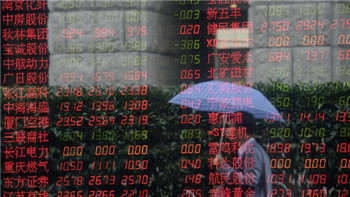(单词翻译:单击)

Just over a decade ago I wrote a book about the rise and fall of 20th century Japanese finance. I later discovered that a pirated Chinese language copy had been produced.
10年多一点以前,我写过一本关于20世纪日本金融兴衰的书籍。后来我发现,这本书出现了中文盗版版本。
Chinese regulators and bankers came to see me about the book and explained. “We want to understand what happened so we can be different,” the mantra went; Japan’s crazy 1980s bubble was being studied to show what policymakers should not do.
中国监管者和银行家因为这本书来找我,并解释了他们的思路:“我们希望明白发生了什么事情,以便得到不同的结果。”中国方面在研究日本上世纪80年代的疯狂泡沫,以便让政策制定者引以为戒。
It is a point Beijing needs to relearn now, in relation not so much to Japan’s bubble, but to the aftermath. If you want to see what can happen when a government tries to prop up stock and land prices, Tokyo’s story is sobering. It shows that not only do interventions carry a financial cost (since they rarely work for long), but that they can be a lasting drag on investor psychology.
北京方面现在有必要温习日本的教训,这与其说是泡沫的教训,不如说是泡沫破裂之后的教训。如果你想要看看政府试图支撑股票和土地价格的时候会发生什么情况,那么东京的故事令人警醒。它表明,干预不仅会有财务成本(因为它们极少持续管用),而且会对投资者的心理造成持久拖累。
Consider the parallels. In the past two decades China has delivered impressively high economic growth by investing heavily to build an industrial export machine. This was supported by a bank-centred, state-controlled financial system that channelled cheap funding to favoured industries at the expense of consumers. The price of money, in other words, was set by autocratic fiat.
想想两国的相似之处。在过去20年里,中国通过大举投资打造工业出口机器,实现了引人注目的高速经济增长。这种增长受到以银行为中心、政府控制的金融体系的支持,后者在牺牲消费者利益为代价,向重点行业输送廉价融资。换言之,资金的价格由官方制定。
This is roughly what Japan also did in the decades after world war two (although such state control was more subtle and indirect in Japan than in China).
这基本上也是日本在二战后几十年所做的事情(尽管与中国相比,日本的此类政府控制更为微妙和间接)。
But Japan’s model changed from the 1970s onwards. As the country’s economy matured, Japanese companies had less need for bank-supplied cheap credit, and, as it grew wealthy, investors started hunting for places to put their cash. The government slowly started to move away from a bank-dominated, tightly controlled financial system towards something that had the trappings of capital markets open to the outside world. However, Japan’s pace of liberalisation was belated and uneven (if not downright arbitrary) and asset price bubbles developed as capital swirled around.
但日本模式从上世纪70年代开始改变。随着日本经济发展成熟,日本公司对银行廉价信贷的需求下降,而且随着日本越来越富裕,投资者开始寻找投资机会。日本政府逐渐开始从银行占据主导地位、受到严格控制的金融体系,转向貌似向外部世界开放的某种资本市场。然而,日本的自由化步伐既迟缓又没有章法(即使不是完全武断的话),随着大量资本涌动,资产价格被推高,形成了泡沫。
Monetary policy and exchange rate swings made the problem worse. So, by the end of the 1980s, stock and land prices had soared — in much the same way that they have in China, as Beijing has also tiptoed towards patchy liberalisation and embraced some capital market structures.
货币政策和汇率波动让问题更加恶化。因此,到了上世纪80年代末,股票和土地价格大幅飙升——这在很大程度上和中国一样。中国政府近年也不规则地小步走向自由化,拥抱一些资本市场架构。
But the really important lesson is what happened next in Japan.
但真正重要的教训在于日本接下来发生的事情。
In December 1989, the Nikkei share index hit a peak of 38,915.87, but then tumbled, falling 60 per cent in the next two years. Japanese bureaucrats initially assumed this was just a temporary decline, so did not ask banks to reprice the value of their investments or loans. But then, as prices kept falling, the government tried to prop up asset prices, sometimes with explicit share purchases — but usually via more subtle forms of intervention (banks kept rolling over bad loans and big companies kept supporting each others’ share prices).
1989年12月,日经股指触及38915.87点的峰值,但随后大幅下跌,在接下来的两年里跌幅高达60%。日本官僚最初以为这只是临时性的下跌,因此没有要求银行重新定价它们投资或贷款的价值。但接下来随着价格不断下跌,日本政府试图提振资产价格,有时采取公开的购股举措,但通常是通过更为隐秘的干预措施(银行持续滚转坏账,大公司持续相互支撑股价)。
This worked — for a while. By the mid 1990s share prices seemed to have stabilised at lower levels. But in 1997, when news seeped out that the banks were sitting on massive unrecognised losses (which later totalled almost $1tn), a financial crisis erupted, and asset prices slid. By that point, the system was also plagued by a pernicious lack of trust.
这些举措取得了效果,不过只是暂时的。到上世纪90年代中期,股价似乎在较低水平企稳。但在1997年有消息传出银行拥有大量未确认亏损(后来总数达到近1万亿美元)的时候,金融危机爆发了,资产价格暴跌。到了那时,金融体系也深受信任严重匮乏的困扰。
After a decade of (largely futile) meddling, investors no longer believed that Japanese bureaucrats were as powerful as they had seemed in the decades after the second world war. But they did not have much faith in “market” prices either, since everyone knew these were being propped up. Japan was thus in a limbo: the traditional pillars of faith that once supported asset values had crumbled, but there was nothing else to replace them.
在持续10年基本上徒劳的干预之后,投资者不再相信日本官僚真像二战后几十年里貌似的那么无所不能。但他们也对“市场”价格没有多大信心,因为所有人都知道,这些是得到扶持的价格。日本因此陷入困境:曾经支持资产价值的传统信心支柱崩塌,但没有其他支柱可以代替它们。
Nobody really knew the “clearing prices” of assets, as traders like to say, or how far prices might fall if markets were free. Investors were haunted by an uneasy fear that bad news could seep that would push prices down again.
没有人真正知道资产的“清算价格”(交易员喜欢说的术语),也就是如果市场不受干预的话,价格将会下跌多少。投资者感到忧心忡忡,担心可能曝出再次压低价格的坏消息。
Maybe China will avoid Japan’s mistakes; certainly some officials seem keen to try. But right now, the historical echoes are strong. This summer, the Chinese government has used an estimated $200bn to buy shares, and it is now seeking to intimidate investors to prevent share sales. Yet the markets have fallen by about 40 per cent from their peak. Faith in bureaucrats’ ability to underwrite prices is slipping, but trust in market mechanisms is also being undermined.
或许中国将不会重蹈日本覆辙;一些官员肯定似乎热衷于尝试。但就现在而言,两者的历史相似性十分突出。今年夏季,中国政府动用约2000亿美元购股,现在它正设法威逼投资者以阻止他们抛售股票。然而市场距今年最高点已下跌大约40%。市场逐渐不再相信官僚有能力兜底价格,但投资者对市场机制的信任也遭到削弱。
Better just hope, in other words, that Beijing remembers how dangerous it can be when nobody knows how to establish values and when there are no clearing prices, as it looks east across the sea.
换言之,人们最好还是希望中国政府能够隔海东望,记取日本的教训:在没有人知道如何确立价值、没有任何清算价格的时候,局面有可能多么危险。


